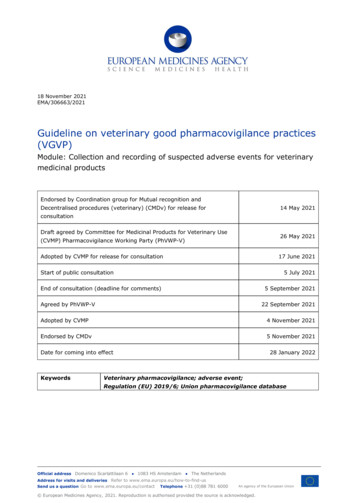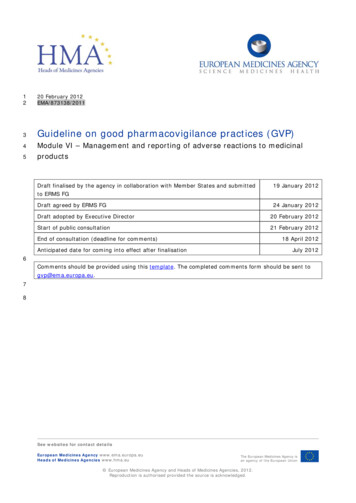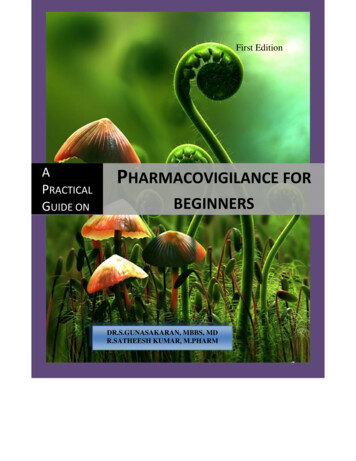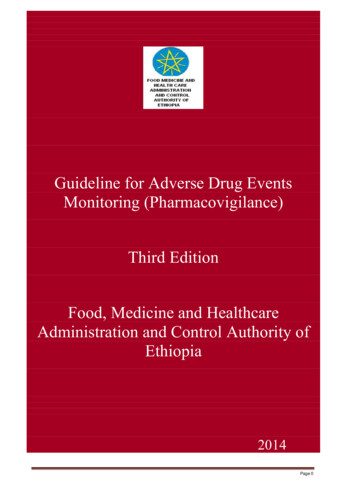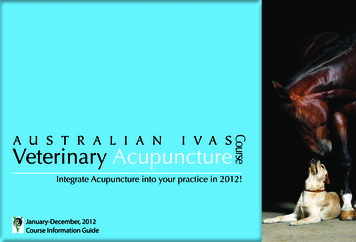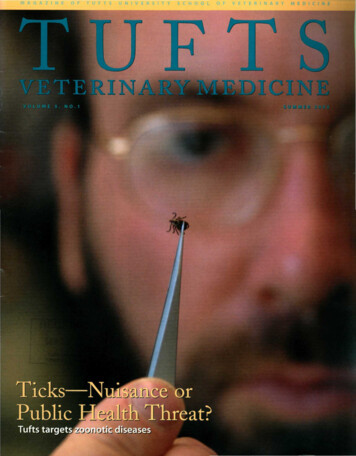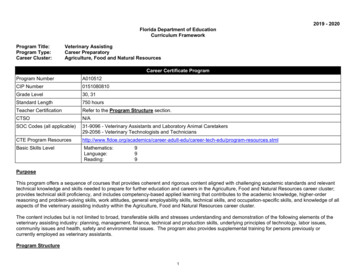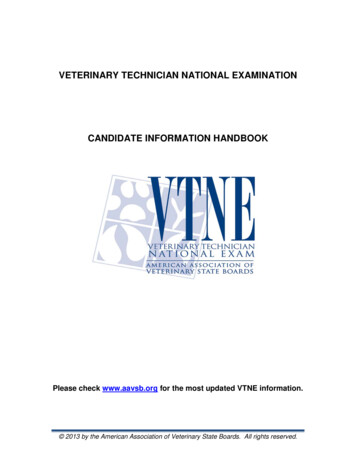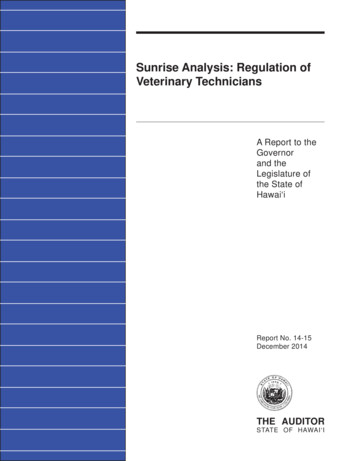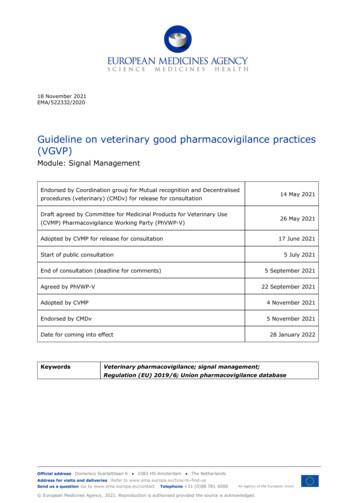
Transcription
18 November 2021EMA/522332/2020Guideline on veterinary good pharmacovigilance practices(VGVP)Module: Signal ManagementEndorsed by Coordination group for Mutual recognition and Decentralisedprocedures (veterinary) (CMDv) for release for consultationDraft agreed by Committee for Medicinal Products for Veterinary Use14 May 202126 May 2021(CVMP) Pharmacovigilance Working Party (PhVWP-V)Adopted by CVMP for release for consultation17 June 2021Start of public consultation5 July 2021End of consultation (deadline for comments)5 September 2021Agreed by PhVWP-V22 September 2021Adopted by CVMP4 November 2021Endorsed by CMDv5 November 2021Date for coming into effectKeywords28 January 2022Veterinary pharmacovigilance; signal management;Regulation (EU) 2019/6; Union pharmacovigilance databaseOfficial address Domenico Scarlattilaan 6 1083 HS Amsterdam The NetherlandsAddress for visits and deliveries Refer to www.ema.europa.eu/how-to-find-usSend us a question Go to www.ema.europa.eu/contactTelephone 31 (0)88 781 6000An agency of the European Union European Medicines Agency, 2021. Reproduction is authorised provided the source is acknowledged.
Table of Contents1. Introduction . 32. Structures and processes . 32.1. Signal management activities by marketing authorisation holders . 32.2. Data sources in signal management . 52.3. Signal prioritisation . 52.3.1. Emerging Safety Issues . 52.3.2. Signals involving Medically Important (MI) VeDDRA terms . 62.3.3. Prioritisation criteria for other types of signals . 62.4. Signal detection . 72.5. Evaluation during signal validation and further assessment . 82.6. Recommendation for action by the marketing authorisation holder . 92.6.1. Signal is refuted . 102.6.2. Close monitoring . 102.6.3. Post-marketing surveillance study . 103. Operation of the EU network . 103.1. Roles, responsibilities, and procedural aspects. 113.2. Recording of the outcome of signal management by the marketing authorisation holder. 123.2.1. Signals which require reporting without delay . 123.2.2. Annual submission including annual statement . 123.3. Incidence reporting by marketing authorisation . 133.4. Reporting of other additional information . 133.5. Targeted signal management by the competent authorities and the Agency . 143.6. Transparency. 144. Quality management system requirements . 14Definitions . 15Appendix 1. Medically Important (MI) VeDDRA terms list . 16Guideline on veterinary good pharmacovigilance practices (VGVP) – Signal managementEMA/522332/2021Page 2/17
1. IntroductionThis module of the guideline on veterinary good pharmacovigilance practices (VGVP) brings togethergeneral guidance for marketing authorisation holders, national competent authorities and the EuropeanMedicines Agency (the “Agency”) regarding signal management for veterinary medicinal productsauthorised in the European Union (EU).Article 17(5) of Commission Implementing Regulation (EU) 2021/1281 requires the Agency to publishguidance on best practice for signal management.The objectives of this module are: to provide general guidance on scientific and quality aspects of signal management for veterinarymedicinal products; to describe the roles, responsibilities, and procedural aspects of the EU signal management processfor veterinary medicinal products.This module is applicable to veterinary medicinal products authorised in the EU irrespective of theauthorisation procedure (centralised or national procedure, including mutual recognition, decentralisedand subsequent recognition procedures) and registered homeopathic veterinary medicinal products.Unless stated otherwise, the guidance provided in this module applies predominantly to marketingauthorisation holders but should also be considered by all organisations involved in the signalmanagement process; national competent authorities, the coordination group, the Agency and theCommission.For the scope of this module, the responsibilities of registration holders of homeopathic veterinarymedicinal products are the same as those for marketing authorisation holders.The guidance in this module will be reviewed and updated in the future based on the experience gainedon the signal management process from all stakeholders.This module should be read in conjunction with Regulation (EU) 2019/6 of the European Parliamentand of the Council of 11 December 2018 on veterinary medicinal products and repealingDirective 2001/82/EC (the Regulation) and Commission Implementing Regulation (EU) 2021/1281,laying down rules for the application of Regulation (EU) 2019/6 of the European Parliament and of theCouncil as regards good pharmacovigilance practice and on the format, content and summary of thepharmacovigilance system master file for veterinary medicinal products (the ImplementingRegulation).2. Structures and processes2.1. Signal management activities by marketing authorisation holdersMarketing authorisation holders should continuously monitor the safety of their veterinary medicinalproducts, in order to promptly detect any new safety issues that may impact the benefit-risk balanceso that adequate regulatory actions and communication (where necessary) can be taken incoordination with the competent authorities and the Agency. New safety issues may include a new riskassociated with the product or the active substance or a change to a known risk.A signal is defined as information that arises from one or multiple sources, including observations andexperiments, which suggests a potentially new causal association, or a new aspect of a known causalassociation between an intervention and an adverse event or a set of related adverse events, that isGuideline on veterinary good pharmacovigilance practices (VGVP) – Signal managementEMA/522332/2021Page 3/17
judged likely to justify further investigation of possible causality (Article 1(c) of CommissionImplementing Regulation (EU) 2021/1281).New aspects of a known association may include changes in the frequency, distribution (e.g. gender,age, breed and country), duration, severity or outcome of an adverse reaction.A signal often relates to all veterinary medicinal products containing the same active substance,including combination products. Certain signals may only be relevant for a particular veterinarymedicinal product or in a specific indication, strength, pharmaceutical form or route of administrationwhereas some signals may apply to a whole class of veterinary medicinal products.In practice, for signals involving spontaneous reports, usually several case reports are needed totrigger a signal. Only in very rare cases would a single well-documented report concerning a seriousadverse event or involving several animals be enough to trigger a signal. As a simple rule in the Unionpharmacovigilance database, cumulatively over the full life cycle of a veterinary medicinal product, aminimum of 3 case reports is needed for signals concerning Medically Important (MI) VeDDRA terms(see section 2.3.2) or 5 case reports for signals involving any other VeDDRA terms. However, flexibilityshould always be applied, and this should not be understood as a strict rule.The identification of new risks associated with a veterinary medicinal product should be based on thedetection and analysis of signals, in accordance with the signal management process. The signalmanagement process should consist of, but not be limited to, the pharmacovigilance activities of signaldetection, prioritisation, validation, assessment, and recommendation for action.In case of an impact on the benefit-risk balance of the veterinary medicinal product concerned, onanimal health and welfare or public health, or on protection of the environment that is considered anemerging safety issue, identified by the marketing authorisation holder according to Article 58(10) ofRegulation (EU) 2019/6, the marketing authorisation holder should notify it to the relevant competentauthority(ies) without delay and no later than 3 working days following their identification (see section2.3.1).Where the outcome of the signal management process identifies a change to the benefit-risk balanceor a new risk, the marketing authorisation holder shall notify it without delay and no later than 30calendar days to competent authorities, and where necessary submit a variation to the terms of themarketing authorisation in accordance with Articles 77(10) and 81(2) of Regulation (EU) 2019/6.Figure 1. Overview of the signal management process for veterinary medicinal products.Guideline on veterinary good pharmacovigilance practices (VGVP) – Signal managementEMA/522332/2021Page 4/17
2.2. Data sources in signal managementSignals can arise from several data sources, including all scientific information from the use ofveterinary medicinal products, i.e. quality, non-clinical, clinical data and post-marketing data.The most common sources for detecting signals include spontaneous reporting systems, clinicalstudies, and scientific literature. Marketing authorisation holders shall carry out signal management fortheir veterinary medicinal products, taking into account all relevant pharmacovigilance data of whichthey can reasonably be expected to be aware of and which may be useful for that signal managementprocess, including sales data (see Article 81(1) of Regulation (EU) 2019/6). Please also refer to theguidance on the collection and recording of suspected adverse events associated with veterinarymedicinal products in the relevant VGVP module.2.3. Signal prioritisationSignal management should follow a risk-based approach which takes into account the type of medicinalproduct or active substance concerned, the length of time on the market and the stability of thepharmacovigilance profile (i.e. based on knowledge gained about the safety and efficacy of the productover its full life cycle).In order to avoid delaying the detection and management of certain signals that might require urgentattention, signal prioritisation should be performed throughout the whole signal management process,from signal detection to signal assessment. Prioritisation furthermore allows for identifying andfocusing on those signals with a potential for significant impact on the benefit-risk balance of theveterinary medicinal product or its active substance or those signals with a high impact on animal orpublic health and thus require more urgent attention.Appropriate measures should be considered at any stage if the information available suggests thatthere could be a risk that requires prevention or risk minimisation in a timely manner. Clinicaljudgement and flexibility should be applied throughout the process.The following subsections are presented in order of importance, with emerging safety issues andsignals involving medically important terms being the most important issues to identify and prioritise.2.3.1. Emerging Safety IssuesAny new information which might influence the assessment of the benefits and the risks of veterinarymedicinal product according to Article 58(10) of Regulation (EU) 2019/6, and which may requireurgent regulatory action and communication, should be identified as an emerging safety issue. Itshould be reported to the relevant competent authority(ies), without delay and no later than 3 workingdays after its identification. Examples include: major safety issues identified in the context of ongoing or newly completed studies, e.g. anunexpected increase in rate of fatal or life-threatening adverse events; major safety issues identified through spontaneous reporting or published in the scientificliterature, which may lead to considering a contraindication, a restriction of use of the veterinarymedicinal product or its withdrawal from the market; major safety-related regulatory actions outside the EU, e.g. a restriction of the use of theveterinary medicinal product or its suspension.Events that are associated with the use of a veterinary medicinal product in human as part of a suicidalattempt should not be considered an emerging safety issue.Guideline on veterinary good pharmacovigilance practices (VGVP) – Signal managementEMA/522332/2021Page 5/17
In some cases, emerging safety issues may concern or involve a quality issue or specific batch recallsmay be necessary. However, a batch recall on itself is not considered an emerging safety issue.When a marketing authorisation holder in the EU becomes aware of an emerging safety issue from anysource, they should notify the competent authority(ies) of the Member State(s) where the veterinarymedicinal product is authorised and the Agency. This should be done as soon as possible and no laterthan 3 working days after establishing that a validated signal or a safety issue from any source meetsthe definition of an emerging safety issue.When notifying an emerging safety issue, the marketing authorisation holder should describe thesafety issue, the source(s) of information, actions taken or any planned actions with timelines, andshould provide any relevant documentation available at the time of initial notification. Any furtherinformation relevant to the issue should be provided to the Agency and relevant national competentauthorities as soon as it becomes available.Upon being notified of an emerging safety issue, the national competent authorities or the Agency asappropriate will promptly assess the urgency and potential impact of the issue and agree onappropriate next steps and the potential regulatory procedure to address the matter raised. This mayinvolve consultation with the incident review group, if warranted (see incident management plan formedicines for veterinary use1).The marketing authorisation holder should collaborate with the Agency and national competentauthorities in the assessment of emerging safety issues.2.3.2. Signals involving Medically Important (MI) VeDDRA termsA list of Medically Important (MI) terms has been developed (Appendix 1) using VeDDRA. This listcontains serious medical concepts at the level of VeDDRA preferred terms. It is intended to be used bymarketing authorisation holders, the Agency and national competent authorities for signalprioritisation.Signals involving MI VeDDRA terms should always be prioritised even in the absence of any statisticaldisproportionality measure (e.g. ROR2), unless they are already considered adequately reflected in thecurrent product information.2.3.3. Prioritisation criteria for other types of signalsIt is not uncommon for veterinary medicinal products used widely or in diseased animals to have arelatively large number of potential signals generated. Many such signals are false positives andfurther prioritisation is essential.When prioritising newly identified signals other than emerging safety issues or signals involving MIterms, the following criteria, or a combination thereof, should be considered: Novelty of the medicinal product-event association. The focus should be on new associations ornew aspects of a known association, such as a change in frequency, severity, duration or temporalpersistence, further anatomical specification, change in the outcome or reported fatality rate. Strength of the evidence supporting the association, including the number of case se en.pdfReporting Odds Ratio (ROR) is a statistical measure based on the odds observed for an event occurring with a particularproduct compared to the odds observed of that same event in a reference data set of products.12Guideline on veterinary good pharmacovigilance practices (VGVP) – Signal managementEMA/522332/2021Page 6/17
Seriousness, severity, outcome or reversibility of the event involved and the potential forprevention. ROR value (not exclusive, i.e. a non-significant ROR does not exclude a potential signal). Public health and environmental protection implications. Species-specific events.Results from previous analyses of identified signals can be used as a prioritisation criterion, e.g. asignal that was previously refuted, but where new cases are expected to provide further supportingevidence and re-opening of the signal.In some cases, signals that could cause media attention and/or public concerns may deserve specialattention. These include situations where compliance with certain treatments or public health measuresmay be affected by misinformation originating in e.g. the general public at risk of not adhering toproven vaccination schemes in pets on the basis of unfounded information in social media.2.4. Signal detectionIf a marketing authorisation holder is responsible for the same or similar veterinary medicinal productsin different Member States authorised through different authorisation procedures, signal detection andthe signal management process shall be performed by grouping all products considered the same orsimilar3.Depending on the size and nature of the database used, signal detection may involve the review ofindividual spontaneous reports, the use of statistical analyses, or a combination of both. Aggregateddata analyses and the use of several data sources can also increase the quality of the process.When using the Union pharmacovigilance database for signal detection, the marketing authorisationholder should make use of the available pre-defined queries in the Union pharmacovigilance database.These include: Signal detection dashboard: overview, signal detection with RORs up to date 2 and up to date 1(cumulative ROR), static ROR evaluation. Signal evaluation dashboard: animal data (species/breed, age, weight analysis, pharmaceuticalform, regional distribution, time to onset), product information (pharmaceutical form, regionaldistribution), product association (product used in association with another product), associatedVeDDRA terms (other reactions in the same adverse events reports). Incidence calculation queries 4. If needed, more tailored queries can be constructed based on the individual data elements.The outputs of the Union pharmacovigilance database are generally provided at the level of the activesubstance or combination of active substances. Outputs can also be generated on a product basis.Marketing authorisation holders can use their own specific data analytical tools for the purpose ofsignal detection and assessment, when available. It is acknowledged that other analytical tools,including other statistical methods that are known to be used in the field of pharmacovigilance, such asBayesian methods, can be used by marketing authorisation holders in their own databases and can beuseful to detect signals. However, all marketing authorisation holders shall conduct at least one signalVICH GL24 on pharmacovigilance of veterinary medicinal products: management of adverse event reports (AERs).Incidence calculation queries are expected to become available from 2023 onwards (Article 75, 3(a) of the Regulation EU2019/6)34Guideline on veterinary good pharmacovigilance practices (VGVP) – Signal managementEMA/522332/2021Page 7/17
detection analysis per year for each of their active substances or products in the Unionpharmacovigilance database (Article 17(7) of Commission Implementing Regulation (EU) 2021/1281).This signal detection analysis should be performed within 2 months before the annual due date (seesection 3.1).2.5. Evaluation during signal validation and further assessmentThe evaluation of the data supporting a detected signal can be divided in different steps.Signal validation is the first step in analysing a detected signal. Signal validation means evaluating theinitial data supporting a signal, in order to verify that the available information contains sufficientevidence demonstrating the existence of a new potential causal association, or a new aspect of aknown association, and therefore justifies further analysis.As a minimum it is expected that the marketing authorisation holder should check at this step that: the event occurred after exposure to the medicinal product (i.e. there is a temporal association); the signal is not based on duplicate reports; the suspected adverse event is not already adequately reflected in the current product information.Even if certain VeDDRA terms are not explicitly included in the product information it may be thecase that the observed clinical signs are already covered by the text included in the productinformation.Other information that can be checked at this step is, for example, if the signal concerns an increase inthe number of reports involving an expected event, reflected in the product information, that thisincrease is not related to an increase in sales volumes or other external factors that might stimulatethe reporting (e.g. increased media attention, etc.).Signal validation serves thus as a first quality check of the cases and the evidence supporting a signalin light of any previous experience, e.g. previous cases reported, previous analyses done on the sameissue, any information available on the same issue in other regulatory procedures, etc. Non-validatedsignals do not require any further in-depth assessment and should not be recorded in the Unionpharmacovigilance database.Once a signal is validated, further assessment shall be performed by the marketing authorisationholder.The assessment of the signal should be as comprehensive as possible in order to reach a high-qualitydecision and signal outcome. The assessment should include a cumulative review of all availableevidence (i.e. not only the cases received during a certain reporting period, but all previously reportedsimilar cases). In this cumulative review, the available pharmacological, pre-clinical, clinical, andepidemiological data from all sources should be reviewed, as applicable, in order to conclude on apotential causal association between the veterinary medicinal product and the concerned suspectedadverse event.Some elements regarding the clinical relevance of the reaction such as the seriousness, severity, theoutcome and reversibility, are important in the assessment of a signal.The following elements should be considered, as applicable, when performing the assessment: Total number of cases (after exclusion of duplicates), and from those, the number of supportivecases, e.g. cases showing a compatible time to onset, positive de- or rechallenge, lack of potentialalternative causes, assessed as possibly related by the reporting veterinarian or healthcareprofessional, with supportive results of relevant investigations.Guideline on veterinary good pharmacovigilance practices (VGVP) – Signal managementEMA/522332/2021Page 8/17
Incidence (see section 3.3). Additional cases reported with related terms (e.g. other VeDDRA terms indicating clinicalcomplications or different stages of the same reaction). Consistency of the evidence across cases (e.g. consistent time to onset, pattern with repeatedobservations of an association). Quality of the data and their supporting documentation. Dose-reaction relationship. Possible mechanism based on biological and pharmacological plausibility. Disproportionality of reporting, if applicable. Potential drug-drug interactions.Additional sources of information may provide further evidence for or against a potential causalassociation and may be considered: Experimental, non-clinical data and clinical trial data. Findings regarding similar cases in the scientific literature, including information on substances ofthe same class of veterinary medicinal products. Information on the epidemiology of the adverse reaction or the underlying disease. Databases with larger datasets, if available. Information from other regulatory authorities worldwide.2.6. Recommendation for action by the marketing authorisation holderAs a result of the assessment of a signal, the marketing authorisation holder should conclude whetherthe available evidence reviewed supports a potential causal association, or not, between the veterinarymedicinal product or active substance concerned and the suspected adverse event and therefore, if thisadverse event constitutes a new risk, including a new aspect of a known adverse reaction. If it isconcluded that the safety profile of the product or active substance has changed, the need foradditional risk minimisation measures and any other regulatory actions should be considered, includinga variation to the terms of the marketing authorisation.This leads to the following possible actions to be considered, as appropriate, by the marketingauthorisation holder following signal assessment; The available evidence supports a causal association resulting in a change to the benefit-risk or anew risk: The new risk is considered an emerging safety issue (see section 2.3.1). Notify within 30 calendar days with a proposal for the necessary action (Article 81(2) ofRegulation (EU) 2019/6) and any risk minimisation measures as applicable. The available information suggests that a potential causal association is at present unlikely; Signal refuted, no further action besides routine pharmacovigilance (see section 2.6.1).The available information is insufficient to conclude on a potential causal association at present butfurther information is expected to provide evidence that could change this conclusion:Guideline on veterinary good pharmacovigilance practices (VGVP) – Signal managementEMA/522332/2021Page 9/17
Close monitoring (see section 2.6.2). A post-marketing surveillance study is required to further investigate the issue (see section2.6.3).2.6.1. Signal is refutedWhen the available information suggests that the observed adverse events are more likely associatedwith other factors not related to the exposure of the veterinary medicinal product, e.g. to theunderlying condition of an animal, exposure to other medicines, etc. the signal can be refuted andclosed without the need for any additional regulatory actions (i.e. routine pharmacovigilance activitieswill continue to be performed). In this case, the signal could still be reopened in the future should anynew relevant information become available.2.6.2. Close monitoringIn some cases, it might be decided that the signal should not be closed and some further follow-up(i.e. close monitoring) is required. In this case, the marketing authorisation holder should report ateach yearly due date on the status of the signals under close monitoring. This approach should befollowed for signals where the overall available information is insufficient to exclude a potentialassociation with exposure to the veterinary medicinal product. Shorter reporting time-periods for theclose monitoring of certain signals may be set by the relevant competent authority(ies)(e.g. 6-months).For signals under close monitoring for an extended period (e.g. more than 2 years) stopping of theclose monitoring can be proposed at the time of the yearly submission (i.e. due date) with a detailedjustification.2.6.3. Post-marketing surveillance studyIn some cases, it might be concluded that spontaneous data are not enough to evaluate a certainpotential risk identified through signal management. Additional data collection may be needed toconclude on the potential causal association with the veterinary medicinal product. In these cases, themarketing authorisation holder may propose to voluntarily conduct a post-marketing surveillancestudy. In exceptional cases, a post-marketing surveillance safety study may also be requested by theAgency or national competent authorities (Article 76(3) and (4) of Regulation (EU) 2019/6).3. Operation of the EU networkFigure 2 below summarises the continuous signal management performed by marketing authorisationholders and the different types of submissions to competent authorities throughout a year ofsurveillance.Guideline on veterinary good pharmacovigilance practices (VGVP) – Signal managementEMA/522332/2021Page 10/17
Figure 2. Summary overview of the continuous signal management process performed by marketingauthorisation holders throughout a year of surveillance3.1. Roles, responsibilities, and procedural aspectsMarketing authorisation holders are responsible for the continuous monitoring of pharmacovigilancedata and the assessment of the benefit-risk balance of their veterinary medicinal products(Articles 77(4) and 81 of Regulation (EU)
Guideline on veterinary good pharmacovigilance practices (VGVP) - Signal management EMA/522332/2021 Page 6/17 In some cases, emerging safety issues may concern or involve a quality issue or specific batch recalls

